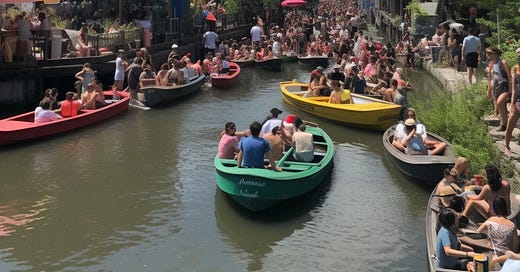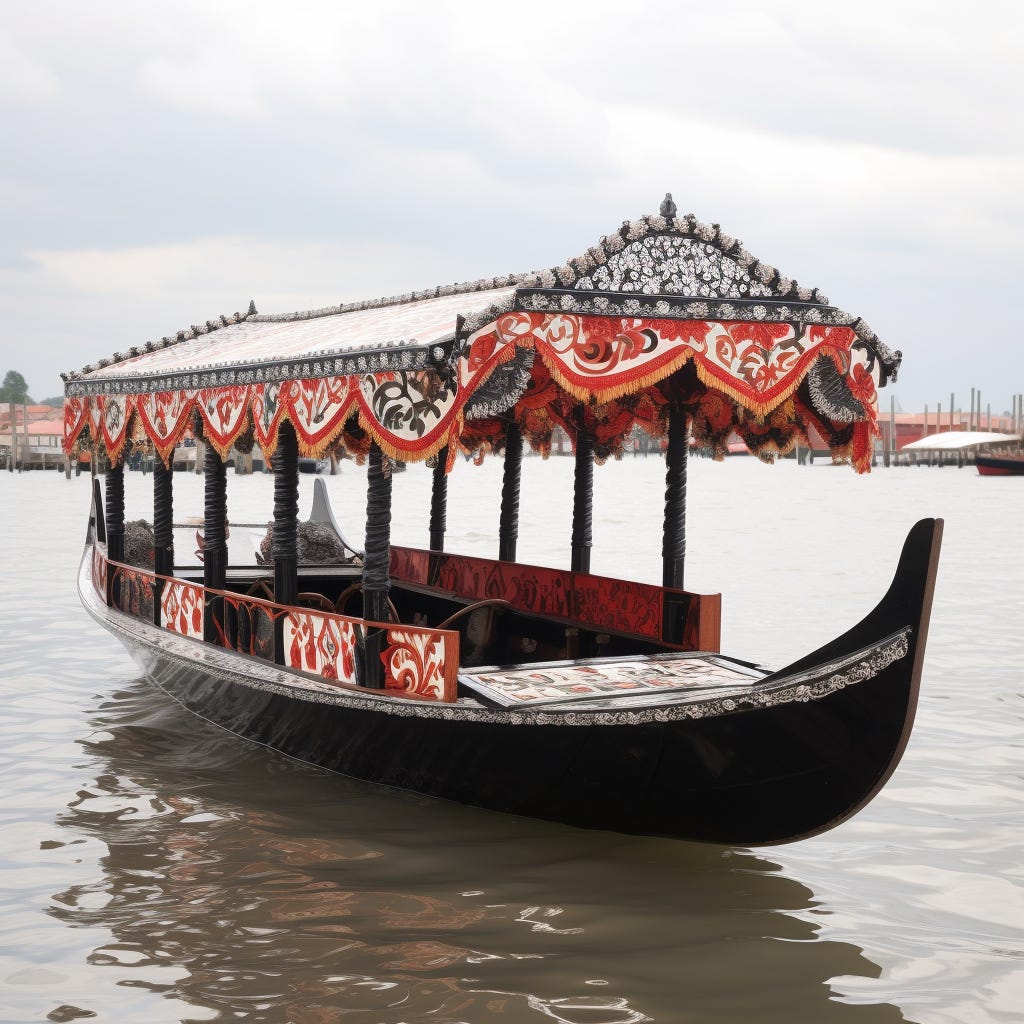As the sun casts its rays on a picturesque Sunday in June, I find myself floating along the Gowanus Canal, the one-time superfund site now transformed into a thriving urban oasis. Nestled between Park Slope and Red Hook on the western edge of Brooklyn, its formerly black-brown-green color-shifting waters have been replaced with a shimmering dark greenish blue that reflects the sky overhead.
About a decade ago, I had gone to a bar near the Gowanus with my cousin and remember the sulfuric rotten egg smell that had accosted us as we walked. The stench is a distant memory though - my nose is now delighted by the wafting aromas of street food and the gentle fragrance of blossoming flowers that line the edges of the canal in hanging planters.
Our gondola, adorned with black, white and red spiral patterns painted by a local New York artist, glides gracefully through the water alongside a flotilla of other colorful gondolas, each designed by a different artist and guided by gondoliers hefting long wooden poles. The scene is reminiscent of the canals of Xochimilco in southern Mexico City, where vibrant trajinera boats packed with families, friends and tourists float and party all day along wide waterways. Today we're on a picnic with our guide, a woman named Zazie wearing a bright fuchsia dress. She and her boat, the Lavender Sleigh, were recommended by a friend who’d come the month before with her family.
Zazie slows our gondola down with some deft jabs and gives us a quick intro to the Gowanus:
Ladies and gentlemen, welcome aboard the Lavender Sleigh, the trusty boat separating us from the once-terrifying waters of the Gowanus Canal! Allow me take you back in time to learn about the fascinating and checkered past of this historic waterway. Once dubbed ‘Lavender Lake’ for its unique, otherworldly hue, the Gowanus Canal took decades to clean up - the blue waters you see here today were hard won and cost hundreds of millions of dollars and countless hours of labor.
At 1.8 miles long and 100 feet wide, this canal was completed in the 1860s and was initially built to accommodate the booming industrial growth of Brooklyn - at its busiest, as many as 100 ships a day transported cargo through it. As Brooklyn’s industry grew, chemical fertilizer and coal plants popped up on its edges, pouring toxic waste directly into its waters and eventually turning the canal into a viscous sludge that some described as ‘Black Mayonnaise’. Raw sewage, and even the occasional mobster casualty, rounded out the fetid contents of the canal that offended the noses of generations of Brooklynites for blocks around.
A far cry from its gloomy toxic past, the atmosphere on today’s canal is lively and spirited, with an abundance of skirts, shorts, tanned limbs, sunglasses and smiles. I’m grateful for the gondola’s colorful canopy providing shade overhead and the slight breeze as we drift along. At intervals of around 500 meters we pass floating stages hosting live bands - first a folk band with two twanging banjos, then a classical music quartet, and finally a DJ, each attracting a cluster of gondolas and creating its own pocket of sound along the canal.
Other gondolas we pass are filled with joyful celebrations - birthday parties, reunions, a number of other picnickers like ourselves, and what looks like a bachelorette party all wearing matching tiaras. It's a beautiful tapestry of human connection bringing life to the once-toxic canal.
As our boat meanders along the waterway, we encounter an array of vendor gondolas, like floating food trucks, each offering a tantalizing selection of foods and drinks. From fresh tacos and steamed dumplings to churros, bibimbap, crepes, spring rolls, and smoothies, the culinary offerings are as diverse as the city itself. Payments are seamless and contactless, with most vendors sporting a large stylized QR code for quick and easy transactions.
I wait for us to approach a dim sum gondola, a sign with a grinning bun-shaped anime mascot greeting us as we dock, and give them my order as steam wafts up from the stacks of baskets holding delicious morsels.
In addition to the culinary delights, we encounter floating coffee barista boats, crafting cappuccinos, lattes and affogatos. Bar boats serve up a variety of tasty inebriants, including the Black Mayo, which, as I read on one of their chalk boards, is a dark concoction of vodka, activated charcoal, crème de cassis, Kahlúa, and ginger beer. Intrigued, I order one for myself and find it surprisingly delicious and refreshing, a fun nod to the old nickname for the canal’s sludge.
As our boat continues down the canal, we discover other vendors interspersed among the food, drink and music offerings selling local Brooklyn and New York crafts, hats, soaps, jewelry, as well as some daytime floating essentials like sunscreen. One gondola catches my eye, offering handmade flower crowns crafted from real flowers. Zazie guides us up alongside and I purchase one and place it on my partner's head, adding to the enchanting ambiance of the day.
The Gowanus Canal, once a symbol of environmental degradation, has been reborn as a haven of culture, music, food, and community. This day spent floating along its serene waters, surrounded by friends and embraced by the warmth of the sun, is a testament to the power of renewal and the indomitable spirit of New York City.





